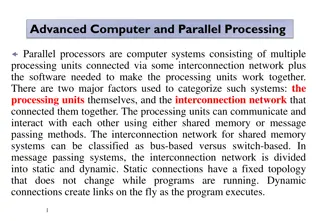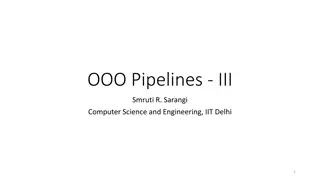Understanding Pipelined Control in Processor Architecture
Explore the intricacies of pipelined control in processor design, detailing the control signals required at each stage of the pipeline. Learn about data hazards, forwarding, and stalling techniques to ensure efficient instruction execution. Dive into the concept of optimized control values for streamlined processor performance.
Download Presentation

Please find below an Image/Link to download the presentation.
The content on the website is provided AS IS for your information and personal use only. It may not be sold, licensed, or shared on other websites without obtaining consent from the author. Download presentation by click this link. If you encounter any issues during the download, it is possible that the publisher has removed the file from their server.
E N D
Presentation Transcript
Chapter 4 The Processor 1
Pipelined Control We need only set the control values during each pipeline stage: 1. Instruction fetch: The control signals to read instruction memory and to write the PC are always asserted, so there is nothing special to control in this pipeline stage. 2. Instruction decode/register file read: We need to select the correct register number for read register 2, so the signal Reg2Loc is set. The signal selects instruction bits 20:16 (Rm) or 4:0 (Rt). 3. Execution/address calculation: The signals to be set are ALUOp and ALUSrc. The signals select the ALU operation and either Read data 2 or a sign-extended immediate as inputs to the ALU. 4. Memory access: The control lines set in this stage are Branch, MemRead, and MemWrite. The compare and branch on zero, load, and store instructions set these signals, respectively. Recall that PCSrc selects the next sequential address unless control asserts Branch and the ALU result was 0. 5. Write-back: The two control lines are MemtoReg, which decides between sending the ALU result or the memory value to the register file, and RegWrite, which writes the chosen value. 3
Pipelined Control Nine control lines grouped by pipeline stage: Reg2Loc to read the right register instruction bit 28 is a 0 for R-format instructions and a 1 for the rest connect instruction bit 28 to Reg2Loc Extend the pipeline registers to include control information these control signals are then used in the appropriate pipeline stage as the instruction moves down the pipeline 4
Pipelined Control Control signals derived from instruction as in single-cycle implementation Three of the eight control lines are used in the EX phase, with the remaining five control lines passed on to the EX/MEM pipeline register 5
Pipelined Control Full datapath with the extended pipeline registers and with the control lines connected to the proper stage along with the instruction bit 28 controlling the Reg2Loc register address multiplexor 6
4.7 Data Hazards: Forwarding vs. Stalling Data Hazards in ALU Instructions Consider this sequence: SUB X2, X1,X3 AND X12,X2,X5 OR X13,X6,X2 ADD X14,X2,X2 STUR X15,[X2,#100] We can resolve hazards with forwarding How do we detect when to forward? Forward to an operation in the EX stage, which may be either an ALU operation or an effective address calculation. When an instruction tries to use a register in its EX stage that an earlier instruction intends to write in its WB stage, we actually need the values as inputs to the ALU. 7
Notation for Dependence A notation that names the fields of the pipeline registers E.g. ID/EX.RegisterRn1 = number of one register whose value is found in the pipeline register ID/EX ID/EX: name of pipeline register, RegisterRn1: name of the field in the pipeline register ALU operand register numbers in EX stage are given by ID/EX.RegisterRn1, ID/EX.RegisterRm2 Data hazards when 1a. EX/MEM.RegisterRd = ID/EX.RegisterRn1 1b. EX/MEM.RegisterRd = ID/EX.RegisterRm2 2a. MEM/WB.RegisterRd = ID/EX.RegisterRn1 2b. MEM/WB.RegisterRd = ID/EX.RegisterRm2 Fwd from EX/MEM pipeline reg Fwd from MEM/WB pipeline reg 8
Dependence Detection Class dependencies in the following sequence: SUB X2, X1,X3 AND X12,X2,X5 OR X13,X6,X2 ADD X14,X2,X2 STUR X15,[X2,#100] The SUB-AND is a type 1a hazard because X2 in the AND instruction is in EX stage and SUB is in the MEM stage. EX/MEM.RegisterRd =ID/EX.RegisterRn1 =X2 The SUB ORR is a type 2b hazard: MEM/WB.RegisterRd =ID/EX.RegisterRm2 =X2 The two dependences on SUB ADD are not hazards because the register file supplies the proper data during the ID stage of ADD. There is no data hazard between SUB and STUR because STUR reads X2 the clock cycle after SUB writes X2. 9
Detecting the Need to Forward But only if forwarding instruction will write to a register! Check to see if the RegWrite signal will be active: examine the WB control field of the pipeline register during the EX and MEM stages EX/MEM.RegWrite, MEM/WB.RegWrite If an instruction in the pipeline has XZR as its destination, avoid forwarding its possibly nonzero result value. E.g. SUBS XZR,X1,2 The conditions work properly as long as we add EX/MEM.RegisterRd 31 to the first hazard condition, and MEM/WB.RegisterRd 31 to the second hazard condition 10
Forwarding Paths By adding multiplexors to the input of the ALU, and with the proper controls, we can run the pipeline at full speed in the presence of these data hazards. 12
Forwarding Conditions Mux control ForwardA = 00 ForwardA = 10 Source ID/EX EX/MEM Explanation The first ALU operand comes from the register file. The first ALU operand is forwarded from the prior ALU result. The first ALU operand is forwarded from data memory or an earlier ALU result. The second ALU operand comes from the register file. The second ALU operand is forwarded from the prior ALU result. The second ALU operand is forwarded from data memory or an earlier ALU result. ForwardA = 01 MEM/WB ForwardB = 00 ID/EX ForwardB = 10 EX/MEM ForwardB = 01 MEM/WB 13
Hazard Conditions and Control Signals 1. EX hazard: if (EX/MEM.RegWrite and (EX/MEM.RegisterRd 31) and (EX/MEM.RegisterRd = ID/EX.RegisterRn1)) ForwardA = 10 if (EX/MEM.RegWrite and (EX/MEM.RegisterRd 31) and (EX/MEM.RegisterRd = ID/EX.RegisterRm2)) ForwardB = 10 This case forwards the result from the previous instruction to either input of the ALU. 14
Hazard Conditions and Control Signals 2. MEM hazard: if (MEM/WB.RegWrite and (MEM/WB.RegisterRd 31) and (MEM/WB.RegisterRd = ID/EX.RegisterRn1)) ForwardA = 01 if (MEM/WB.RegWrite and (MEM/WB.RegisterRd 31) and (MEM/WB.RegisterRd = ID/EX.RegisterRm2)) ForwardB = 01 As mentioned above, there is no hazard in the WB stage, because we assume that the register file supplies the correct result if the instruction in the ID stage reads the same register written by the instruction in the WB stage. Such a register file performs another form of forwarding, but it occurs within the register file. 15
Double Data Hazard Consider the sequence: add X1,X1,X2 add X1,X1,X3 add X1,X1,X4 Both hazards occur Want to use the most recent, i.e. results forwarded from MEM stage Revise MEM hazard condition Only fwd if EX hazard condition isn t true 16























